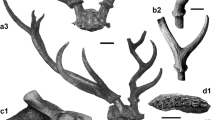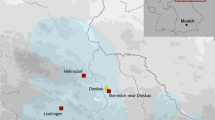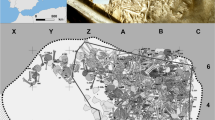Abstract
The Pliocene fossil ‘Lucy’ (Australopithecus afarensis) was discovered in the Afar region of Ethiopia in 1974 and is among the oldest and most complete fossil hominin skeletons discovered. Here we propose, on the basis of close study of her skeleton, that her cause of death was a vertical deceleration event or impact following a fall from considerable height that produced compressive and hinge (greenstick) fractures in multiple skeletal elements. Impacts that are so severe as to cause concomitant fractures usually also damage internal organs; together, these injuries are hypothesized to have caused her death. Lucy has been at the centre of a vigorous debate about the role, if any, of arboreal locomotion in early human evolution. It is therefore ironic that her death can be attributed to injuries resulting from a fall, probably out of a tall tree, thus offering unusual evidence for the presence of arborealism in this species.
This is a preview of subscription content, access via your institution
Access options
Subscribe to this journal
Receive 51 print issues and online access
$199.00 per year
only $3.90 per issue
Buy this article
- Purchase on Springer Link
- Instant access to full article PDF
Prices may be subject to local taxes which are calculated during checkout


Similar content being viewed by others
References
Johanson, D. C. & Taieb, M. Plio–Pleistocene hominid discoveries in Hadar, Ethiopia. Nature 260, 293–297 (1976)
Johanson, D. C. et al. New partial skeleton of Homo habilis from Olduvai Gorge, Tanzania. Nature 327, 205–209 (1987)
Alemseged, Z. et al. A juvenile early hominin skeleton from Dikika, Ethiopia. Nature 443, 296–301 (2006)
White, T. D. et al. Ardipithecus ramidus and the paleobiology of early hominids. Science 326, 75–86 (2009)
Haile-Selassie, Y. et al. An early Australopithecus afarensis postcranium from Woranso-Mille, Ethiopia. Proc. Natl Acad. Sci. USA 107, 12121–12126 (2010)
Walker, A. & Shipman, P. The Wisdom of the Bones (Knopf, 1996)
L’Abbé, E. N. et al. Evidence of fatal skeletal injuries on Malapa Hominins 1 and 2. Sci. Rep. 5, 15120 (2015)
Walter, R. C. Age of Lucy and the first family: single-crystal 40Ar/39Ar dating of the Denen Dora and lower Kada Hadar members of the Hadar Formation, Ethiopia. Geology 22, 6–10 (1994)
Johanson, D. C. et al. Morphology of the Pliocene partial hominid skeleton (A.L. 288-1) from the Hadar Formation, Ethiopia. Am. J. Phys. Anthropol. 57, 403–451 (1982)
Armitage, B. M. et al. Mapping of scapular fractures with three-dimensional computed tomography. J. Bone Joint Surg. Am. 91, 2222–2228 (2009)
Neer, C. S., II. Displaced proximal humeral fractures. I. Classification and evaluation. J. Bone Joint Surg. Am. 52, 1077–1089 (1970)
Edelson, G., Kelly, I., Vigder, F. & Reis, N. D. A three-dimensional classification for fractures of the proximal humerus. J. Bone Joint Surg. Br. 86, 413–425 (2004)
Twiss, T. in Proximal Humerus Fractures: Evaluation and Management (eds Crosby, L. A. & Neviaser, R. J. ) 23–41 (Springer, 2015)
Jaiswal, A. et al. Bilateral traumatic proximal humerus fractures managed by open reduction and internal fixation with locked plates. Chin. J. Traumatol. 16, 379–381 (2013)
Snyder, R. G. Human tolerances of extreme impacts in free fall. Aerosp. Med. 34, 695–709 (1963)
Goonetilleke, U. K. D. A. Injuries caused by falls from heights. Med. Sci. Law 20, 262–275 (1980)
Papadopoulos, I. N. et al. Patients with pelvic fractures due to falls: A paradigm that contributed to autopsy-based audit of trauma in Greece. J. Trauma Manag. Outcomes 5, 2–15 (2011)
Auñón-Martín, I. et al. Correlation between pattern and mechanism of injury of free fall. Strateg. Trauma Limb Reconstr. 7, 141–145 (2012)
Stern, J. T. Climbing to the top: a personal memoir of Australopithecus afarensis. Evol. Anthropol. 9, 113–133 (2000)
Stewart, F. A. & Pruetz, J. D. Do chimpanzee nests serve an anti-predatory function? Am. J. Primatol. 75, 593–604 (2013)
Reed, K. E. Paleoecological patterns at the Hadar hominin site, Afar Regional State, Ethiopia. J. Hum. Evol. 54, 743–768 (2008)
Bonnefille, R., Potts, R., Chalié, F., Jolly, D. & Peyron, O. High-resolution vegetation and climate change associated with Pliocene Australopithecus afarensis. Proc. Natl Acad. Sci. USA 101, 12125–12129 (2004)
Aronson, J. L., Hailemichael, M. & Savin, S. M. Hominid environments at Hadar from paleosol studies in a framework of Ethiopian climate change. J. Hum. Evol. 55, 532–550 (2008)
Yemane, T. Stratigraphy and sedimentology of the Hadar Formation. PhD thesis, Iowa State Univ. (1997)
Campisano, C. J. & Feibel, C. S. Depositional environments and stratigraphic summary of the Pliocene Hadar Formation at Hadar, Afar Depression, Ethiopia. GSA Special Papers 446, 179–201 (2008)
Pontzer, H. & Wrangham, R. W. Climbing and the daily energy cost of locomotion in wild chimpanzees: implications for hominoid locomotor evolution. J. Hum. Evol. 46, 315–333 (2004)
Hernandez-Aguilar, R. A., Moore, J. & Stanford, C. B. Chimpanzee nesting patterns in savanna habitat: environmental influences and preferences. Am. J. Primatol. 75, 979–994 (2013)
Doran, D. M. Sex differences in adult chimpanzee positional behavior: the influence of body size on locomotion and posture. Am. J. Phys. Anthropol. 91, 99–115 (1993)
Warner, K. G. & Demling, R. H. The pathophysiology of free-fall injury. Ann. Emerg. Med. 15, 1088–1093 (1986)
Weilemann, Y., Thali, M. J., Kneubuehl, B. P. & Bolliger, S. A. Correlation between skeletal trauma and energy in falls from great height detected by post-mortem multislice computed tomography (MSCT). Forensic Sci. Int. 180, 81–85 (2008)
Grabowski, M., Hatala, K. G., Jungers, W. L. & Richmond, B. G. Body mass estimates of hominin fossils and the evolution of human body size. J. Hum. Evol. 85, 75–93 (2015)
Ketcham, R. A. & Carlson, W. D. Acquisition, optimization and interpretation of X-ray computed tomographic imagery: applications to the geosciences. Comput. Geosci. 27, 381–400 (2001)
Herman, G. T. Correction for beam hardening in computed tomography. Phys. Med. Biol. 24, 81–106 (1979)
Ketcham, R. A. New algorithms for ring artifact removal. Proc. SPIE 6318, 10.1117/12.680939 (2006)
Acknowledgements
We thank the Authority for Research and Conservation of Cultural Heritage and the National Museum of Ethiopia of the Ministry of Tourism and Culture for permission to scan, study, and photograph Lucy; A. Admassu, K. Ayele, J. A. Bartsch, Y. Beyene, Y. Desta, R. Diehl, R. Flores, R. Harvey, G. Kebede, R. Lariviere, J. H. Mariam, S. M. Miller, L. Rebori, B. Roberts, J. Ten Barge, J. M. Sanchez, D. Slesnick, D. Van Tuerenhout, S. Wilson, M. Woldehan, and M. Yilma for facilitating and assisting with the scanning; T. Getachew and M. Endalamaw for assisting with the photography, and S. Mattox for many of the photographs; V. A. Lopez and S. Robertson for Fig. 2; C. Bramblett, B. Brown, C. Campisano, J. G. Fleagle, T. Helpenstell and colleagues at Olympia Orthopaedic Associates, A. L. Kappelman, J. A. Kappelman, S. Khosropour, H. Pontzer, D. Reed, C. B. Ruff, J. T. Stern Jr, and S. C. Ward for discussions; the Paleoanthropology Laboratory Fund, College of Liberal Arts UT Austin, and Houston Museum of Natural Science for financial and logistical support; and Owen-Coates Fund of the Geology Foundation of UT Austin for publication costs. The University of Texas High-Resolution X-ray CT Facility was supported by US National Science Foundation grants EAR-0646848, EAR-0948842, and EAR-1258878.
Author information
Authors and Affiliations
Contributions
J.K. conceived the project; J.K., R.A.K., S.P., L.T. and M.F. collected data; W.A., M.W.C., J.K. and A.W. completed the 3D reconstruction and video of the right humerus; and J.A.M. completed the 3D videos of the mandible. J.K. wrote the paper with comments from all authors.
Corresponding author
Ethics declarations
Competing interests
The authors declare no competing financial interests.
Additional information
Reviewer Information Nature thanks S. Black, W. Jungers and the other anonymous reviewer(s) for their contribution to the peer review of this work.
Extended data figures and tables
Extended Data Figure 1 Right humerus (A.L. 288-1m) CT segmentation compared with photographs of fossil.
Right proximal humerus (A.L. 288-1m) illustrating the fractured fragments segmented from the CT scans compared with photographs of fossil. Nearly 30 fractured bone and articular head fragments and slivers were isolated by segmentation. Some small fragments remain embedded within the sediment on the posterior aspect of the head. One large fragment was avulsed off of the posteroinferior aspect of the articular head and not recovered. Scale bar, 10 mm. See Methods, Extended Data Fig. 2 and Supplementary Note 1 for a full description; also see Supplementary Video 1.
Extended Data Figure 2 Right humerus (A.L. 288-1m) CT segmentation with ‘before’ reconstruction and ‘after’ discovery state.
Right proximal humerus (A.L. 288-1m) illustrating the head and diaphyseal shaft fragments segmented from the CT scans. The before image presents a reconstruction of the crushed proximal portion of the head that also straightens the spiral fracture at the diaphysis, and the after image shows the condition of the fossil in its discovery state. The impact compressed the proximal humerus against the glenoid of the scapula, with the glenoid acting as an anvil, which in turn fractured and shattered the components of the proximal humerus including the articular head, greater and lesser tuberosities, and shaft. Each pair of before and after images depicts the distal portion of the shaft in the same position and illustrates how the proximal portion of the head and shaft were angled in a posteromedial direction by the fracture. In some pairs of images the proximal end of the humerus is angled slightly towards the viewer to show a greater percentage of the head. Scale bar, 10 mm (approximate because of the differences in perspective). See Methods, Fig. 1, Extended Data Fig. 1 and Supplementary Note 1 for a full description; also see Supplementary Video 1.
Extended Data Figure 3 Mandible (A.L. 288-1i, -1j and -1k) photographs and CT scan.
A comparison of photographs with CT scan of mandible (A.L. 288-1i, -1j and -1k) illustrating in red the major fractures across the parasymphyseal region, left body, and left (A.L. 288-1j) and right (A.L. 288-1k) subcondylar regions; and in green the fractures across the edges of the coronoid processes. The condyles were discovered and catalogued as separate specimens, and there is a set of closed fractures through the right condyle. Binding materials used in the reconstruction of the mandible are seen in yellow in the photographs, and as smooth dark brown in the CT scans. Note the generally tight contacts between adjacent bone fragments. Right p3–m3 teeth are complete whereas the anterior dentition and the teeth on the left side are fractured along the base of their crowns or are missing. This fracture pattern is typical of a tripartite guardsman fracture with fractures at parasymphysis and bilateral fractures in the subcondylar region. a, b, Left anterolateral view; c, d, right anterolateral view; e, f, superior view. Scale bars, approximately 10 mm because of angled views. See Supplementary Note 1 for a full description; also see Supplementary Videos 2, 3.
Extended Data Figure 4 Mandible (A.L. 288-1i, -1j and -1k) CT scan.
CT scan of mandible (A.L. 288-1i, -1j and -1k) illustrating in red the major fractures across the parasymphyseal region, left body, and left (A.L. 288-1j) and right (A.L. 288-1k) subcondylar regions. The coronoid processes are missing and their fractured edges outlined in green. This fracture pattern is typical of a tripartite guardsman fracture with fractures at parasymphysis and bilateral fractures in the subcondylar region. a, Anterior view; b, posterior view; c, superior view; d, inferior view. e–g, Anterior views of coronal slices: e, slice through the centre of canine alveolae that shows the major parasymphyseal fractures; f, slice at mesial edge of m3; and g, slice through mesial edge of coronoid process that shows the position of the right and left subcondylar fractures. Scale bar, 10 mm. See Supplementary Note 1 for a full description; also see Supplementary Videos 2, 3.
Supplementary information
Supplementary Information
This file contains Supplementary Notes 1-8, Supplementary References and Supplementary Methods. Please note a set of 3D.stl files of the right shoulder and left knee are available for download at www.eLucy.org. (PDF 1216 kb)
Right humerus (A.L. 288-1m) and scapula (A.L. 288-1l) compressive fracture reconstruction
Video of hypothetical impact scenario for the right humerus and scapula that illustrates the progression of the fracture. The "before" reconstruction of the humerus is seen in the first full rotation. Next, the fragments are colorized and the humerus is impacted into the anvil of the glenoid of the scapula, fracturing and shattering the components of the proximal humerus including the articular head, greater and lesser tuberosities, and shaft. Finally, the "after" condition is shown in the last rotation. See Methods, Extended Data Figures 1 & 2, Supplementary Note 2 for a description of the reconstruction, and Supplementary Video 4. (MOV 31197 kb)
CT scan coronal slices of mandible (A.L. 288-1i, -1j & -1k)
Video of CT scan (see Methods) of the original reconstruction of the mandible illustrates the fractures across the mandible and especially those in the parasymphyseal region, left body, and subcondylar regions. Slices are in the coronal plane. The smooth dark brown regions are binding materials used in the reconstruction. This fracture pattern is typical of a tripartite guardsman fracture. See Extended Data Figures 3 & 4 for the location of the fractures, and Supplementary Note 1 for a full description. (MOV 19822 kb)
CT scan sagittal slices of mandible (A.L. 288-1i, -1j & -1k)
Caption as in Supplementary Video 2. Slices are in the sagittal plane. (MOV 16618 kb)
Lucy’s fall and vertical deceleration event
Stop motion video depicts a hypothetical scenario for Lucy’s fall out of a tall tree and the subsequent vertical deceleration event based on the patterning of the fractures. The first segment depicts about the last half of the fall from 7.4 m with a real time duration of 0.45 seconds, and the second segment shows a close-up of the last 2.2 m of the fall. The third segment shows a slow-motion (about 1/5 speed) close-up of the last 1.7 m of the fall. The last frame illustrates the fractures. See Figure 2 for a full description. (MP4 20579 kb)
PowerPoint slides
Rights and permissions
About this article
Cite this article
Kappelman, J., Ketcham, R., Pearce, S. et al. Perimortem fractures in Lucy suggest mortality from fall out of tall tree. Nature 537, 503–507 (2016). https://doi.org/10.1038/nature19332
Received:
Accepted:
Published:
Issue Date:
DOI: https://doi.org/10.1038/nature19332
This article is cited by
-
Open plains are not a level playing field for hominid consonant-like versus vowel-like calls
Scientific Reports (2023)
-
Inhumation and cremation: identifying funerary practices and reuse of space through forensic taphonomy at Cova Foradada (Calafell, Spain)
Archaeological and Anthropological Sciences (2022)
-
Something Scary Is Out There: Remembrances of Where the Threat Was Located by Preschool Children and Adults with Nighttime Fear
Evolutionary Psychological Science (2021)
-
Complex vocal learning and three-dimensional mating environments
Biology & Philosophy (2021)
-
Something Scary is Out There II: the Interplay of Childhood Experiences, Relict Sexual Dinichism, and Cross-cultural Differences in Spatial Fears
Evolutionary Psychological Science (2021)
Comments
By submitting a comment you agree to abide by our Terms and Community Guidelines. If you find something abusive or that does not comply with our terms or guidelines please flag it as inappropriate.



